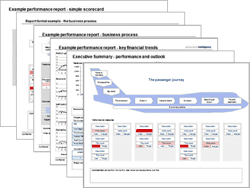Monthly Executive Reporting: Making it happen
seeing a prototype ... the mock-up
The executive report is a living (paper) document, designed for use in the monthly meeting, to be referred to, annotated and waved around.

Because its design is quite different from the standard spreadsheets and essays, a mock-up is the best way to illustrate how this might look.
So, drawing on the recommendations in the diagnostic study, we build a report. We design its presentation and prioritise the content to meet the objectives of the meeting.
The mock-up is typically 20-30 pages long. It has a summary of the key information and analysis followed by sections with more detail. The mock-up can again be produced very quickly, often within two weeks.
The document prompts feedback from the executive team and gains commitment to the new reporting style and content.
Significant elements of the report will always need input from your reporting team, but the collection and graphical presentation of much of the data can in due course be automated.
Before that, the next stage is to implement manual reporting, refining the mock-up by producing a ‘live’ report and using it in the monthly meeting.
using it for real ... manual reporting
Once the mock-up has been presented and changes agreed, it is often possible to prepare a report with current performance data in time for the next monthly meeting.
At this stage the content and the way you use the report has not been settled, so all elements are produced manually, an intense and time-consuming activity.
Data is not enough - the report requires commentary and analysis to identify the important threads and highlight areas for decision and action – and the reporting team needs to develop methods and styles for this analysis. This is the first stage in our handover of this capability to your team.
Because it is time-consuming, making time for analysis is especially challenging during this manual reporting stage, but once the report design is settled – sometimes after just one cycle – its production can be made quicker and more efficient by automation.
producing it efficiently ... automation
Once content and format have been agreed, the production process can be streamlined, allowing your reporting team to focus on where it adds most value – analysis, not data collection and presentation.
The executive report cannot simply be an automated dashboard. Its comprehensive scope makes this impractical and more importantly its need for insight makes it impossible – how can the presentation of this month’s key issues be ‘hard-wired’ in advance?
However, the benefits of automation – speed, accuracy and consistency – must be achieved, to give the reporting team time for the essential analysis and for deciding how to present the key messages.
So the next stage is to implement ‘light’ automation. This collects data (from any source and in any format required) to produce skeleton report pages - with measures, charts and graphs - which together form an outline report. To this outline can be added analysis and commentary.
Automation typically uses your desktop software and is independent of the corporate databases in place - we have worked with a range of ERP and Business Intelligence systems (SAP, Hyperion, Cognos, Progress, etc.).
This dramatically reduces the time required each month for data preparation and review - from five days to one, in one recent case - and reduces the risk of errors by removing ad-hoc spreadsheets.
We are very aware of the need to balance flexibility, efficiency and reliability. Both the organisation and the reporting team will change over time so the system is fully documented and is designed for you to maintain and refine over time.
Once automation is in place – typically after four to six weeks – and your team can deliver an insightful report each month, we hand over fully, providing further support if you require.
doing it right and keeping it fresh ... support
Reporting is best done by your in-house team, but we can provide further support if required.
Success for us is an excellent report - an essential tool for your executive team - regularly produced by you. One of our principles is to make sure this is in place and then to have the integrity to leave.
But some clients prefer a short period of further support for reporting to 'bed in' and for the reporting team to gain experience of the process. In such cases we provide on-site, on-line or telephone support.
Over time the business and its management will change and reporting needs will change accordingly. Some refinement is readily accommodated within the reporting structure, but if you require more significant development we can of course also support this.
We recommend you review your reports formally at least once a year, to confirm they meet fully users’ needs - it is often the case that clear reports lead to demands for more information. Again, we can support you to structure these reviews and to refine reports, maintaining clarity and conciseness.
Some examples of this approach in action are described in our case studies.

.jpg)